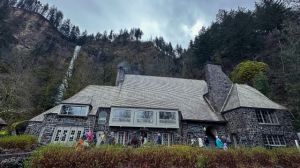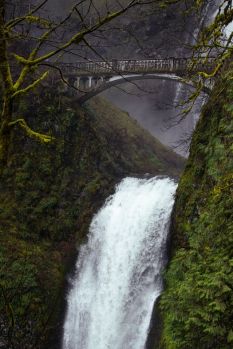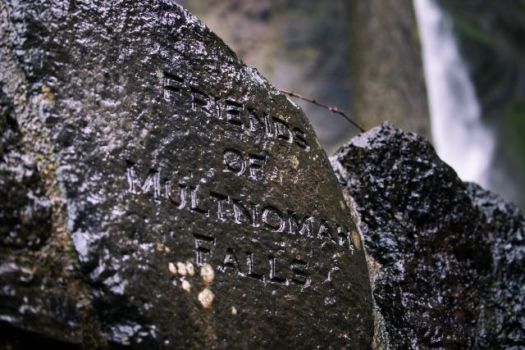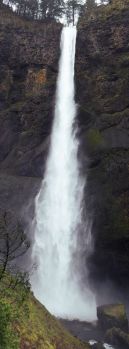Celebrate spring at Multnomah Falls, Oregon’s tallest waterfall
Published 6:45 am Thursday, April 24, 2025
Multnomah Falls is the state’s most recognizable natural feature and our most visited natural space. The tallest waterfall in Oregon, its double falls plunge 620 feet from a cliffside in the Columbia River Gorge.
Over thousands of years, the waterfall has seen its fair share of change, from rockslides to fires and millions of people standing in awe of its splendor. The falls and the equally iconic lodge that shares its name remain among the best views in the state.
The Multnomah Falls Lodge celebrates its centennial this year and is still welcoming troves of visitors from around the globe into its cozy confines as they take in the breathtaking sights that surround it.
Thanks to this winter’s ample, now melting, snowpack, this spring is the perfect time to go chasing waterfalls and there is nowhere as picture perfect as the falls of the gorge.

Moss grows in abundance along the rocks throughout this section of the Scenic Columbia River Gorge.
(Makenzie Whittle)
Stepping up
Stepping into view of the majestic falls can take your breath away.
The rushing of the water as it makes its drop is powerful: It echoes on the cliffsides and drowns out the conversations of the throngs of visitors snapping photos every chance they get.
A quarter-mile paved path takes hikers uphill from the lodge at the base of the falls to the picturesque stone Benson Bridge, where you may find yourself drenched in mist as you take in the full force of the upper falls crashing to the rocks below.
Here, you can continue up to the top of the falls, navigating the pavement, uneven from years of use and land movement, for a full 2.2-mile out-and-back hike up the hill. Or connect to another gorge trail for even more elevation and more views of the Columbia River beyond.
Historic views
Fed by runoff springs from Larch Mountain, Multnomah Falls has been churning up beauty for as long as there have been people around to see it.
The Chinookian-speaking peoples including the Wasco, Klickitat and Multnomah who lived in the Columbia River Gorge for thousands of years have always known this place with their own stories that connect to it, including a legend that states the falls formed when a young woman sacrificed herself to save her people from a great sickness.
Geologically, the falls formed around 15,000 years ago as a result of the Missoula Floods that ripped down from the glacial lake in present-day Montana, carving out layers of basalt rock and leaving the gorge as we see it today with epic cliffsides chiseled from mountainsides that give us its staggering number of waterfalls.
Multnomah Falls stands at a combined 620 feet with the upper falls plummeting 542 feet and the lower falls dropping an additional 69 feet (the 9 remaining feet is the elevation descent between the two falls), making it the tallest waterfall in Oregon. Contrary to many claims, it is not the second tallest year-round waterfall in the country, but that doesn’t make it any less extraordinary.
When European-Americans settlers began arriving in the area it wasn’t long before the falls were the hot spot for staggering beauty in Oregon.
According to Mt. Hood History, in the 1880s the railroad operated a train stop at the falls and a bridge was first built spanning the waters at the base of the upper falls. By the 1910s tourism kicked into gear and with it the autotourists, sparking the need for a highway through the Gorge as well as hiking trails.
Sam Benson, a Portland businessman and owner of the land the falls sits on, worked with the U.S. Forest Service on trails up Larch Mountain and hired stonemasons to build the now famous stone bridge that bears his name, connecting a trail up the mountain at the falls.
Benson then donated 1,400 acres to the city of Portland with the railroad and station at the base of the falls following suit. All that remained was a place for people to stay, rest and take in the beauty of the falls on their day trips from the city.
The lodge
Designed by architect Albert B. Doyle and funded by the City of Portland, the $40,000 build was crafted in a Cascadian design that features every kind of rock found in the Columbia River Gorge on its stone face, marrying it with its natural surroundings.

The Multnomah Falls Lodge with the falls behind in late March. The lodge celebrates 100 years in 2025. (Heather Kelly)
The Multnomah Falls Lodge opened its doors in 1925 and has been part of the draw that brings over 2 million visitors a year to this spectacular place.
Originally featuring lodging for overnight travelers, nowadays you can’t stay there but you can find a well-stocked, and often busy, gift shop, snack and coffee stand, a Forest Service information center and a full restaurant that offers breakfast, lunch and dinner service.
Despite the rare closures due to wars, fires and occasional weather, the lodge and the falls continue to be worthy stops — to take a hike, snap a photo or simply let the raging waters inspire.
Getting around
The spring thaw and usually wetter weather bring high flows to the falls of the Gorge. The popular destination is bound to be even busier this year. With so much use, there are strains on infrastructure here, such as the Historic Columbia River Highway undergoing viaduct construction around Multnomah Falls.
All the waterfalls along the historic route are still accessible, but you’ll need to plan ahead and do some backtracking in order to catch them all.
For Multnomah Falls, you can reach it easily by taking the left-hand Exit 31 (yes, off the fast lane) along Interstate 84 or you can reach it on the westbound side of the HCRH using Exit 34 at Ainsworth State Park.
The construction is due to finish by Memorial Day, but check before you head out to ensure the way you want to go is open.









